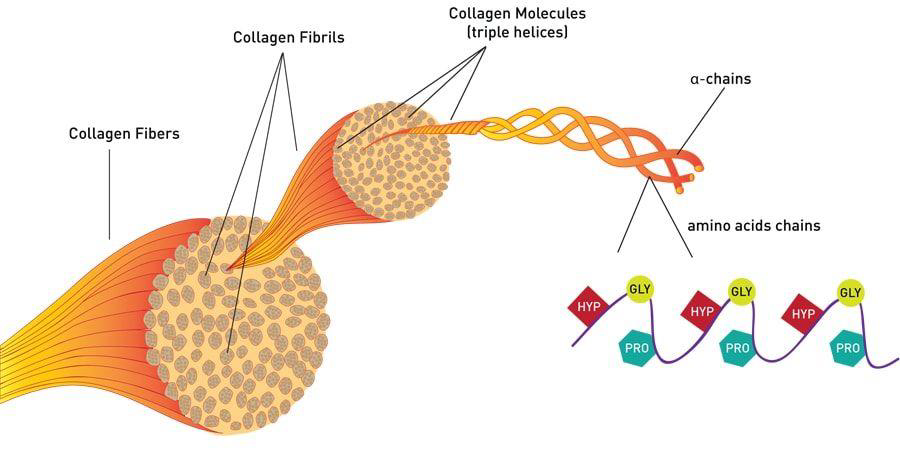Dein Einkaufswagen ist ziemlich leer
Zum Shop gehen
03 After - An introduction to collagen
In this article we will describe what collagen is.
The information described in this article comes from research carried out by Wageningen University & Research on behalf of and in collaboration with Victus.
The collagen family consists of several proteins which are the most abundant in mammals as they make up 30% of the total proteins. Collagen is the main compound in connective tissue. Collagen is a term that is used to describe proteins that form a triple helix of three polypeptide chains. As demonstrated in Figure 2, these polypeptide chains can fold into fibrils and in turn makeup collagen fibres (Gelse, Pöschner & Aigner, 2003). All collagens have this supramolecular structure but they differ in size, function and tissue distribution. The synthesis of collagens starts with the transcription of a gene followed by translation and post-translational modification. The regulation of gene transcription varies with the different cell types. The exact mechanisms behind the regulation of transcription of these genes are not yet established (Gelse, Pöschner & Aigner, 2003).
So-called fibrillar collagens have an important role in the architecture and mechanical properties of various tissues. Including for instance the tensile strength of the skin and the resistance to traction in ligaments. 28 different types of collagens have been identified and these are indicated with Roman numerals (I-XXVIII) (Ricard-Blum, 2011). Collagen occurs in the extracellular matrix (ECM) of tissues such as cartilage, bone, skin and tendon. So-called fibril-forming collagens are the main source of tensile strength in animal tissues. Collagen can be ingested through the diet in many different forms, for example in the form of gelatin. Gelatin is a mixture of different peptides that have all been derived from collagen; the parent protein. Gelatin can be synthesised by breaking some of the cross-links between the polypeptide chains. By further degrading gelatin or collagen through enzymatic hydrolysate, gelatin hydrolysates and collagen hydrolysates can be made (Liu et al., 2015). Collagen hydrolysate (or collagen peptide) is the enzymatically degraded product of gelatin, which has increased solubility and absorption (Shigemura et al., 2018). By breaking the bonds between the collagen peptides their amino acid composition is not changed.
So-called fibrillar collagens have an important role in the architecture and mechanical properties of various tissues. Including for instance the tensile strength of the skin and the resistance to traction in ligaments. 28 different types of collagens have been identified and these are indicated with Roman numerals (I-XXVIII) (Ricard-Blum, 2011). Collagen occurs in the extracellular matrix (ECM) of tissues such as cartilage, bone, skin and tendon. So-called fibril-forming collagens are the main source of tensile strength in animal tissues. Collagen can be ingested through the diet in many different forms, for example in the form of gelatin. Gelatin is a mixture of different peptides that have all been derived from collagen; the parent protein. Gelatin can be synthesised by breaking some of the cross-links between the polypeptide chains. By further degrading gelatin or collagen through enzymatic hydrolysate, gelatin hydrolysates and collagen hydrolysates can be made (Liu et al., 2015). Collagen hydrolysate (or collagen peptide) is the enzymatically degraded product of gelatin, which has increased solubility and absorption (Shigemura et al., 2018). By breaking the bonds between the collagen peptides their amino acid composition is not changed.
The mechanism by which gelatin is absorbed and distributed in tissues was investigated in mice and rats by Oesser et al. (1999) and Watanabe-Kamiyama et al. (2010). Oesser et al. (1999) investigated the absorption of gelatin hydrolysate in mice and found that within the first 12 hours after ingestion, 95% of the gelatin hydrolysate was absorbed. They also found that gelatin hydrolysate accumulated in the cartilage, but the reason for this is not yet known. Alcock et al. (2019) investigated the amino acid concentrations in the blood after the consumption of collagen and found that mainly glycine was present in the blood at high levels, which is in line with the fact that the amount of glycine is the highest of all amino acids in collagen. Generally, peptides are hydrolysed in the gastrointestinal tract, which means that mainly free amino acids will enter the circulation, however, Watanabe-Kamiyama et al. (2010) found that it also entered the circulation in peptide form. Oesser et al. (1999) found peptides with a molecular weight ranging from 1 kDa to ~10 kDa after the absorption in the small intestine, which suggests that there is also a certain amount of gelatin hydrolysate that is absorbed in a higher molecular form. Similar findings were obtained by Wang et al. (2015) who additionally investigated the bioavailability of gelatin. The bioavailability of a compound is important to know for any substance that is taken orally as it determines how much of the compound enters the circulation and thus can have an effect on the body (Hebert & Mattison, 2013). Wang et al. (2015) calculated the relative bioavailability by measuring the amount of compound that ends up in the circulation relative to a reference that was also administered orally, they found this to be 74.12%. They also calculated absolute bioavailability by measuring the amount of compound that ends up in the circulation relative to an intravenous dose, they found this to be 85.97%. Overall, it has been demonstrated that ingestion of collagen peptides leads to the uptake of free amino acids as well as larger peptides, and the bioavailability is relatively high as a significant amount enters the circulation. Since collagen is an important compound in the body and its bioavailability after ingestion is high, it could have potential uses as a nutritional supplement, for example, to enhance collagen production in the body. Collagen supplementation (CS) has been investigated in regard to sports, joint health, muscle repair and injury. These interventions used animal collagen peptides for supplementation, which corresponds with the bovine collagen protein peptides in 03 After.

